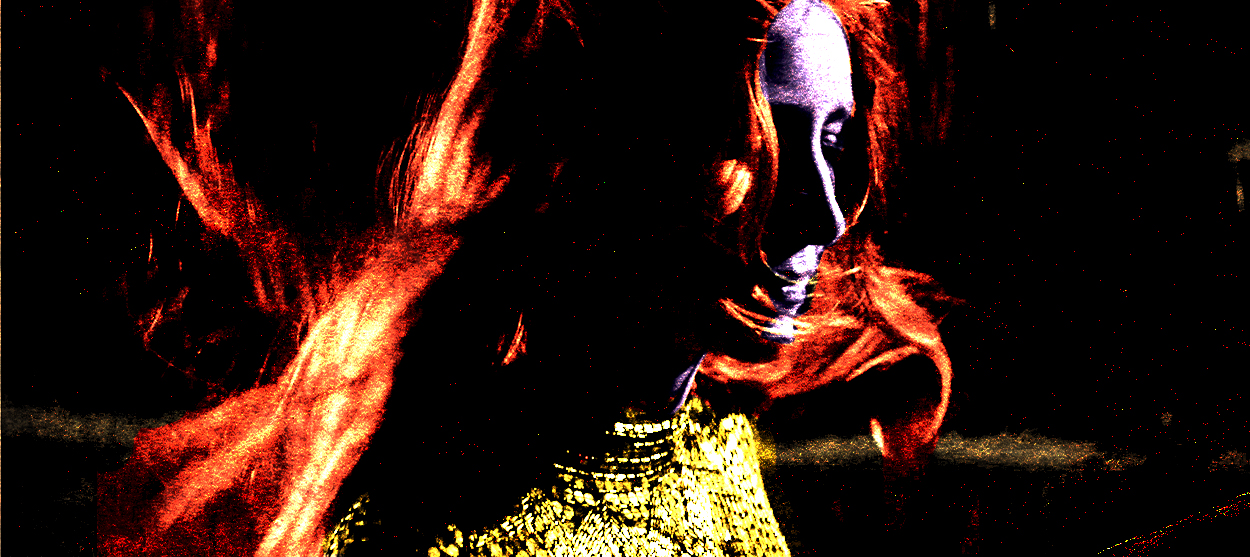Let the Corpses Tan is an exhausting movie. That's what makes it great.
Directors Hélène Cattet and Bruno Forzani thumb their noses at the idea that once a moment passes, it's gone for good


Movies can only show us so much information on screen at a time. It's a fact of the medium; once a moment passes, it's usually gone for good. Maybe, if it serves the story, we'll revisit bygone scenes in a flashback — but probably not.
With their bloodstained neo-Western Let the Corpses Tan, Hélène Cattet and Bruno Forzani defiantly thumb their noses at this truism.
Cattet and Forzani are not the first filmmakers to muck about with chronal affairs or show their audience one event filtered through multiple character viewpoints. Akira Kurosawa arguably did it first, or maybe best, with his 1950 masterpiece Rashomon — a film so good, and with such colossal influence, that some smartypants named a narrative convention after it. (Fittingly, no one agrees on who coined the term.)
The Week
Escape your echo chamber. Get the facts behind the news, plus analysis from multiple perspectives.

Sign up for The Week's Free Newsletters
From our morning news briefing to a weekly Good News Newsletter, get the best of The Week delivered directly to your inbox.
From our morning news briefing to a weekly Good News Newsletter, get the best of The Week delivered directly to your inbox.
But Let the Corpses Tan, out Friday, modifies the Rashomon effect by ignoring contradiction — the tool's defining factor. Rather than let dissonant events lie, Cattet and Forzani reconcile conflicts in plot details and character perspectives with an allegro editing style that lets the audience see the same event from several perspectives, filling out their overall understanding of the moment.
The film takes place in a single location: a desert hideout where a gang of thieves, led by the cunning and brutish Rhino (Stéphane Ferrara), lies low after snatching 250 kilograms of gold. The job goes smoothly, but everything after is a fiasco. The hideout is the dwelling of Rhino's apparent co-leader Luce (Elina Löwensohn), a reclusive modernist artist playing host to her lawyer (Michelangelo Marchese) and a writer, Max Bernier (Marc Barbé). On the way back to the hideout after the heist, Rhino and his crew pick up three hitchhikers: Max's wife (Dorylia Calmel), his son, (Bamba Forzani Ndiaye), and his son's maid (Marine Sainsily). Not long after, a pair of leather-clad gendarmes (Hervé Sogne and Dominique Troyes) show up, hot on the trail of the stolen loot.
Everyone immediately starts shooting at each other while attempting to scheme their way out of certain death and into possession of the gold — the treasure at the end of a bloody rainbow.
Cattet and Forzani deftly reconcile the movie's plot with hyperkinetic editing, leapfrogging from one character's perspective to another's. The trick here is that we, the audience, see that reconciliation of events through jumping viewpoints, but the characters don't. They're deprived of our panoramic observation. That's the case for most characters in most movies, and Cattet and Forzani know that. But rather than acquiesce to the norms of linear editing, the duo instead aims to overcome the limitations of perspective by turning back the clock on the same sequence — once, twice, sometimes even three times. The audience sees all — and in seeing all, they get to enjoy an exhilarating display that cinema doesn't normally afford its viewers.
A free daily email with the biggest news stories of the day – and the best features from TheWeek.com
Take the gendarmes' arrival at the hideout, about 27 minutes into the film. The scene is marked by a title card reading 17h30. Cattet and Forzani make liberal use of title cards throughout; it's how they rewind events.
Dismounting their motorcycles, the gendarmes begin their inspection of the area. They nearly mistake each other for enemies, so fixated are they on potential danger. The female officer walks to the compound's main building and accidentally knocks loose the bell by the door; she steps forward and immediately takes a bullet to the eye. Her screams are cut short by another title card: 17h32. Suddenly, we're inside the room where one of Rhino's thugs, "la brute" (Bernie Bonvoisin), lies in bed next to Luce after making love against a slab of meat. (It's exactly as unsettling as it sounds.) The ring of the bell hitting the ground rouses him. He reaches for his gun, aims at Cattet and Forzani's camera, fires, and ... another title card. 17h28.
Cue Rhino waking up from his own nap, running along a hillside, turning at the sound of the brute's gunshot and the gendarme's cries. 17h33: The male gendarme hears the gunshot, sees his partner drop, sees Rhino, sees "le jeune" (Pierre Nisse) aiming a rifle at him. The gendarme dashes for cover — and for a time the title card jumps stop.
This is the language of Let the Corpses Tan: fulgurant cuts from character to character, as we see each of them experience the same event from varying angles. Each experience comprises one distinct dot in Cattet and Forzani's pointillist filmmaking. Another more traditional film could put together the same sequence; we'd see the characters in the same predicaments, reacting to those predicaments in the same way. But the sequence itself would be wholly changed — robbed of the tension Cattet and Forzani build through their edits.
Later, as the chaos of Let the Corpses Tan settles into place, another title card appears: 19h19. The brute and the lawyer concoct a plan of attack in a nighttime rainstorm, holding a wounded Max, his wife, and his son hostage. The brute tells the wife to make a tourniquet for Max, and he kneels to help her. Two gun barrels peer in from the darkness. Their muzzles flash. The brute catches a bullet to the shoulder. 19h22: The surviving gendarme realizes the maid, previously in his custody, has escaped. His ears twitch at the sound of gunshots. 19h21: The maid scrambles through the rain and happens upon a misplaced pistol. She claims it, sneaks up on the brute and the lawyer, and nearly takes her shot. But Rhino beats her to it. They both open fire. Rhino's first bullet slams into the brute; his second grazes the maid's cheek. She fires once, twice, missing both shots — and then the third relieves Rhino of a chunk of his right ear.
The cuts dramatize the characters' convergence on one another in ways that routine filmmaking doesn't. It's disorienting and exhausting, but that's the point. It's not "better," per se, but "different," and the difference freshens up the film's formula, which would otherwise be a routine execution of the "no honor among thieves" crime trope. In Let the Corpses Tan, time — thanks to Cattet and Forzani's tinkering — expands and contracts. All at once, the film feels shorter and longer, slower and faster, than it actually is.
The effect may work for some and not for others. That's all the more reason to watch. Let the Corpses Tan is uniquely dizzying and occasionally hallucinatory — a one of a kind piece of madness driven by the art of the edit.
Bostonian culture journalist Andy Crump covers the movies, beer, music, and being a dad for way too many outlets, perhaps even yours: Paste Magazine, The Playlist, Mic, The Week, Hop Culture, and Inverse, plus others. You can follow him on Twitter and find his collected writing at his personal blog. He is composed of roughly 65 percent craft beer.
-
 Walter Isaacson's 'Elon Musk' can 'scarcely contain its subject'
Walter Isaacson's 'Elon Musk' can 'scarcely contain its subject'The latest biography on the elusive tech mogul is causing a stir among critics
-
 Welcome to the new TheWeek.com!
Welcome to the new TheWeek.com!The Explainer Please allow us to reintroduce ourselves
-
 The Oscars finale was a heartless disaster
The Oscars finale was a heartless disasterThe Explainer A calculated attempt at emotional manipulation goes very wrong
-
 Most awkward awards show ever?
Most awkward awards show ever?The Explainer The best, worst, and most shocking moments from a chaotic Golden Globes
-
 The possible silver lining to the Warner Bros. deal
The possible silver lining to the Warner Bros. dealThe Explainer Could what's terrible for theaters be good for creators?
-
 Jeffrey Wright is the new 'narrator voice'
Jeffrey Wright is the new 'narrator voice'The Explainer Move over, Sam Elliott and Morgan Freeman
-
 This week's literary events are the biggest award shows of 2020
This week's literary events are the biggest award shows of 2020feature So long, Oscar. Hello, Booker.
-
 What She Dies Tomorrow can teach us about our unshakable obsession with mortality
What She Dies Tomorrow can teach us about our unshakable obsession with mortalityThe Explainer This film isn't about the pandemic. But it can help viewers confront their fears about death.



